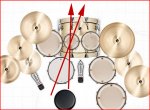BxD
New member
One reason to center low frequency instruments is that human hearing loses directionality below about 300Hz. If listening on speakers it might sound okay to have bass panned, but in headphones where the acoustic cross bleed doesn't happen it can be rather disconcerting to have low frequencies isolated to one ear or the other. But, as it happens, I sometimes have to mix things with panned low frequency instruments, so I place a 300Hz HPF on the difference (side) channel.
That's why in Home Theatre setups, they really don't get fussy where the Sub "should" go -- because you can't tell where the low freqs are coming from anyhow... right?


 ...it's just that the center-forward of the kit is usually in the same direction that the drummer is facing.
...it's just that the center-forward of the kit is usually in the same direction that the drummer is facing. 


